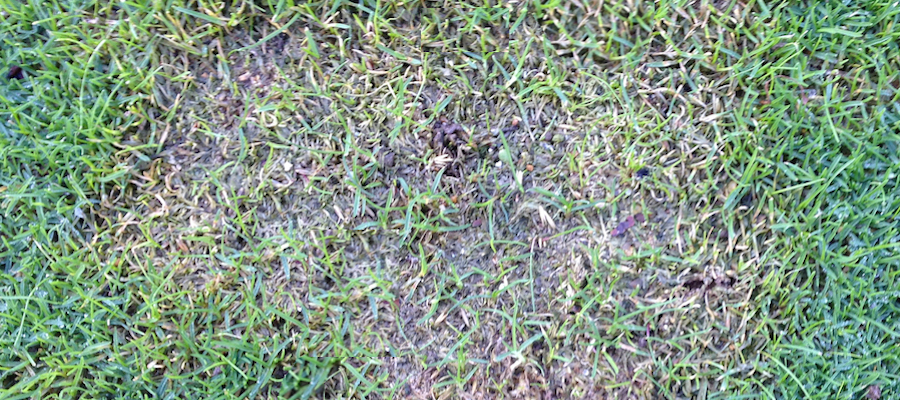Fusarium Patch 

A turfgrass disease which is now more generally referred to as Microdochium patch. It is arguably the most destructive turfgrass disease and most turf grasses are susceptible to it. It can be identified by the following features: An infected area of turf usually ranges from an orange-rusty brown to straw or dark brown colour. It is a circular appearance, typically about 5cm in diameter, with the perimeter of the circle a slightly darker brown colour from the rest of the infected circle. These small 'circles' can spread extremely rapidly to form much larger infected patches of turf.
Photograph of Fusarium patch damage
The infected turf is damp and slimy when the Fusarium is active, and the fungal mycelium can also sometimes be seen on the surface of the grass. As the disease becomes less active to dormant the infected areas dry out and become a straw colour, which is a good time to repair any damage caused.
Fusarium will typically develop in stages:
• Present but not active: Spores are typically present within the sward, but conditions are not suitable for their development, so they are in a dormant stage awaiting more suitable conditions to arise.
• Spores will germinate when conditions become suitable.
• Slight discolouration of leaves indicating early signs of a fusarium attack.
• Initial spread and increase in size of the infected areas.
• Continued spread of the infected areas where suitable conditions are maintained. The mycelium is sometimes seen on the surface of the turf.
• Mature stage of the disease.
The main weed turfgrass that is prone to this disease is annual meadow grass. Highland Bent is more affected than the Common Bent cultivars in fine turf. Creeping Bent, Perennial Ryegrass, and Smooth stalked meadow grass are also susceptible to varying degrees.
Fusarium is favoured by a range of conditions, including:
1. Swards with a high content of annual meadow grass. This is arguably the main underlying cause of why disease attacks occur when environmental conditions are optimal for the fungi.
2. Humid weather, being warm and cool, especially spring and autumn, but it can occur at any time of year.
3. Shade, which slow evapo-transpiration and keep moisture levels higher than exposed areas.
4. Poor air circulation.
5. Forced autumnal growth from late September or October fertilisers, especially higher nitrogen fertilisers.
6. Surface moisture and waterlogged conditions.
7. Neutral to alkaline soil conditions.
8. Increased, excessive, fertiliser use throughout the year.
9. Damaged grass tissue.
10. Thatch depth, with deeper layers retaining moisture for longer periods of time.
11. Applications of lime to turf.
12. Application of neutral to alkaline top-dressings.
13. Application of neutral or alkaline reacting fertilisers.
Where the symptoms appear following the melting of snow, meaning that the disease has developed under snow cover, then it is known as Pink Snow Mould, even though it is the same causal agent.
A comprehensive and integrated range of control measures can be taken, including:
1. Reduce Poa annua content.
2. Reduce thatch layers: both depth and density of them.
3. Avoid using nitrogen fertilisers after late summer.
4. Remove dew early in the morning.
5. Keep the soil well aerated.
6. Box off and remove clippings.
7. Do not smother turf when applying top-dressing and make sure that it is worked into the sward.
8. Improve air circulation around the area: Consider thinning hedges and trees, removing overhanging branches.
9. Use more resistant cultivars, where available.
10. Provide a more acidic soil.
11. Check the pH of top-dressings and aim to use supplies that are on the acidic side.
12. Use sulphate of iron on a regular basis to promote surface acidity, being careful not to over acidify to the detriment of sward quality.
13. Check the pH reaction of applied fertilisers, avoiding neutral to alkaline reacting ones where possible.
14. Ensure mowers have sharp cutting blades and are correctly set.
15. Mow regularly, not infrequently which can stress the grass - especially if 'shaved’.
16. Mow at optimum heights of cut - too short and the grass will be stressed.
17. Reduce fertiliser inputs for shaded parts of surfaces.
18. Improve the drainage system.
19. Chemical control.